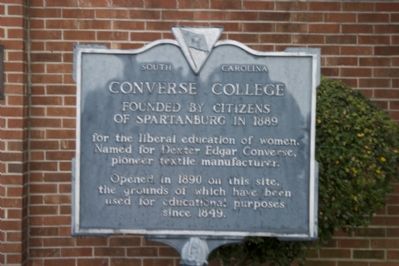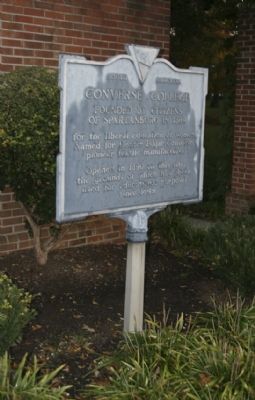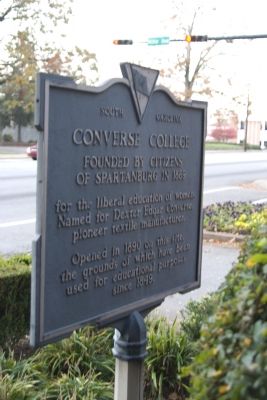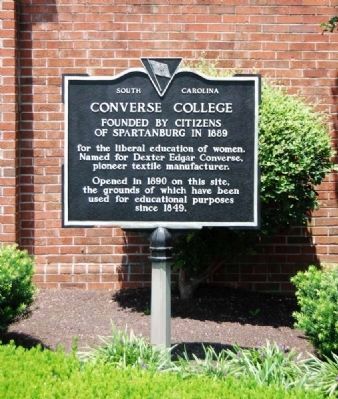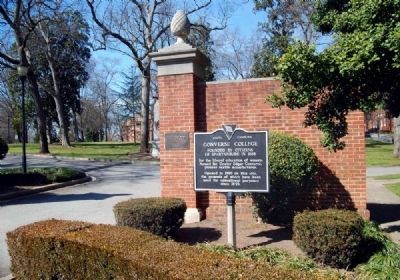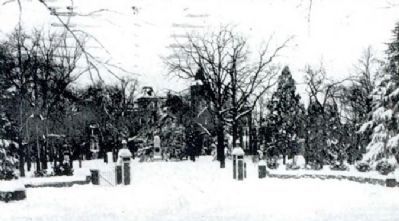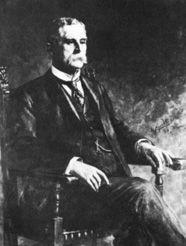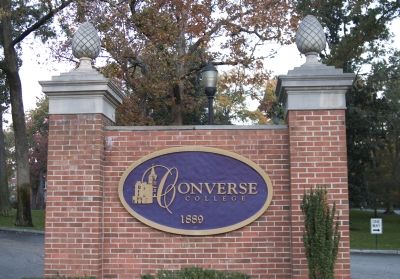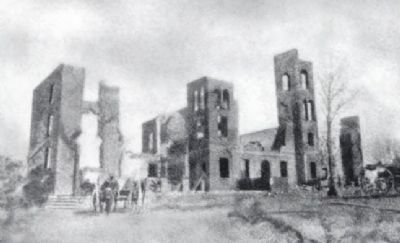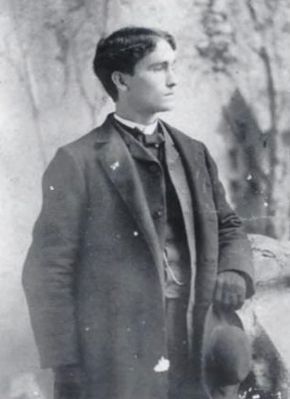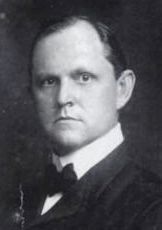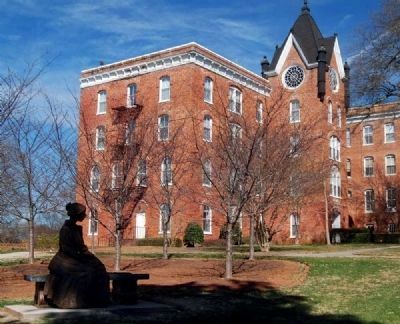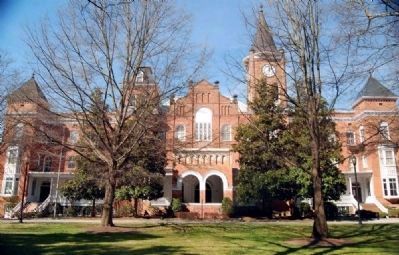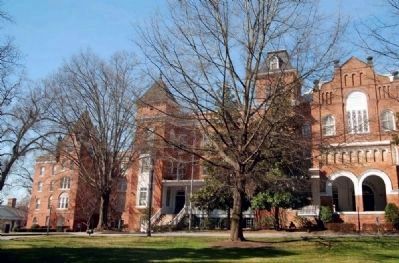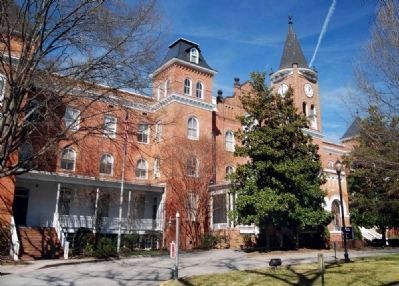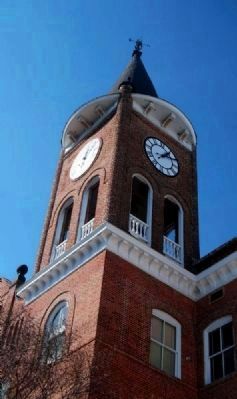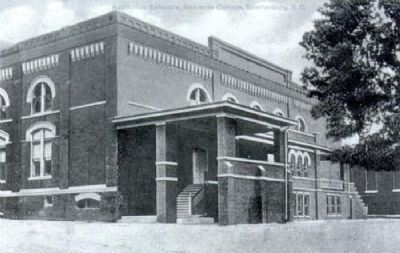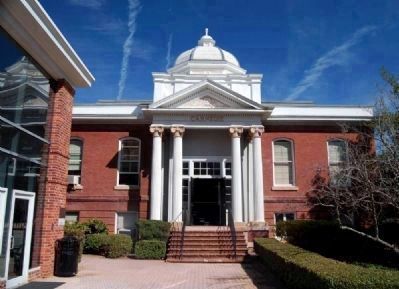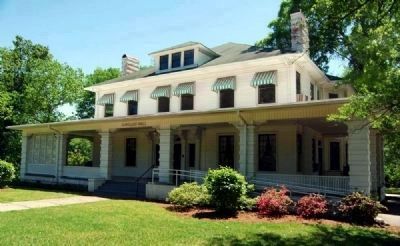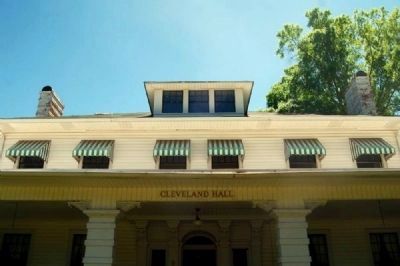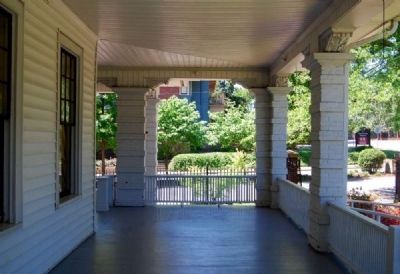Spartanburg in Spartanburg County, South Carolina — The American South (South Atlantic)
Converse College
Spartanburg in 1889
for the liberal education of women.
Named for Dexter Edgar Converse,
pioneer textile manufacturer.
Opened in 1890 on this site,
the grounds of which have been
used for educational purposes
since 1849.
Topics. This historical marker is listed in these topic lists: Education • Landmarks. A significant historical year for this entry is 1889.
Location. 34° 57.263′ N, 81° 55.006′ W. Marker is in Spartanburg, South Carolina, in Spartanburg County. Marker is on East Main Street (U.S. 29) near North Fairview Avenue. Touch for map. Marker is at or near this postal address: 580 E Main St, Spartanburg SC 29302, United States of America. Touch for directions.
Other nearby markers. At least 10 other markers are within walking distance of this marker. Dexter Edgar Converse (a few steps from this marker); Converse Heights (within shouting distance of this marker); Marian Anderson (about 300 feet away, measured in a direct line); Emily Elizabeth Dickinson (about 500 feet away); First Presbyterian Church of Spartanburg, S.C. (approx. 0.4 miles away); Church of the Advent (approx. half a mile away); Daniel Morgan Avenue (approx. half a mile away); Barnet Park (approx. 0.7 miles away); Don Reno / The Blue Ridge Quartet (approx. ¾ mile away); Walter Hyatt / DesChamps Hood (approx. 0.8 miles away). Touch for a list and map of all markers in Spartanburg.
Regarding Converse College. Entry to National Register of Historic Places:
Converse College Historic District (added 1975 - - #75001706)
580 E. Main St. , Spartanburg
• Historic Significance: Event, Architecture/Engineering
• Architect, builder, or engineer: Hook,Charles
• Architectural Style: Late Gothic Revival, Other, Romanesque
• Area of Significance: Education, Architecture, Social History
• Period of Significance: 1900-1924, 1875-1899
• Owner: Private
• Historic Function: Education
• Historic Sub-function: College
• Current Function: Education
• Current Sub-function: College
Also see . . .
1. Converse College. Converse is a is a liberal arts women's college in Spartanburg, South Carolina. (Submitted on August 3, 2008, by Brian Scott of Anderson, South Carolina.)
2. Converse College. Official website of Converse College. (Submitted on August 3, 2008, by Brian Scott of Anderson, South Carolina.)
3. Converse College Historic District. In 1889, citizens concerned with the lack of educational opportunity for young women in the Spartanburg community spearheaded a movement that led to the establishment of Converse College. (Submitted on March 2, 2009, by Brian Scott of Anderson, South Carolina.)
Additional commentary.
1. Converse College Historic District
Converse College was chartered in 1889 and incorporated in 1896. During its first session it had only one building. In September 1891, an additional structure, a 4-story brick building, known as the Annex was completed. It was located near Main Building and connected to it be a covered passageway on the first, second, and third floors. In January 1892 the Main building was destroyed by fire; however, the Annex was saved. The cornerstone of the present Main building was laid April 21, 1892 on the site of the burned structure. The exterior of Main Building, renamed Wilson Hall in 1929 in honor of the first president of Converse, B.F. Wilson, is similar in design to that of the original Main Building. During Converse's formative years Main Building served as a center for the school's activities as well as providing dining facilities, faculty and student living quarters, classrooms, and administrative offices. The Annex, which served as classroom, dormitory, and dining area until the erection of Main Building, is today a dormitory. In 1941 it was named Pell Hall in honor of Converse President Robert P. Pell.
Over the years Converse's enrollment has increase, and the facilities of the school have expanded to meet the growing needs of the campus. Today Converse consists of some 27 structures and has an enrollment of approximately 750 students. The historic district is comprised of six buildings on the Converse front campus, the Towne House behind Pell Hall, and the alumni house (Cleveland House) located across the street from the college.
Historic Structures within the Converse College Historic District:
1. Annex (Pell Hall): 1891, 4 stories, brick, central tower; oldest structure within district; connected by 3-storied passageway to west wing or Wilson Hall.
2. Wilson Hall (Main Building): 1892, Richardsonian Romanesque, 3 stories with elevated basement, brick; central portico; east & west corner towers have hipped roofs & 2-storied bay windows; towers repeated on either side of central portico with eastern tower containing bell.
3. Twichell Auditorium: 1898-1899, 2 stories, brick; arches, designed by Charles Hook; auditorium enlarged in 1908; interior renovated in 1957; connected by one-story bridge to east wing of Wilson Hall.
4. Dexter Hall: 1899, 4 stories, brick, entrance porch; originally contained dormitory suites, gymnasium and later swimming pool and was originally connected to Wilson Hall by covered passageway. Renovated in 1960 and converted into dormitory.
5. Carnegie Library: 1905, 2 stories, brick, entrance porch with pediment, fluted columns with ionic capitals, central dome; today houses Development, Alumni Affairs, and Public Relations offices.
6. Judd Science Hall: 1915, Gothic influence; 2-story brick with central tower, window labels.
7. Towne Hall: 1898. 2 stories, brick, originally watercloset connected to Main Hall; presently used as day-student center.
8. Cleveland House: East Main Street; ca. 1905, 3 stories, frame, one-story porch; hip roof; converted into alumni house in 1974.
Also included within the district is Gwathmey Library. Opened in May 1951, this three-story contemporary brick structure is compatible with other buildings within the district and is not considered an intrusion.
Significance
In March 1889, a group of citizens met in Spartanburg ti discuss the formation of a "female school." Concerned with the lack of educational opportunity for your women in the Spartanburg community, these citizens spearheaded a movement which led to the establishment of Converse College. Included among these interested citizens was Dexter E. Converse, an influential leader of the textile industry in South Carolina and the benefactor for which the college was named. Also attending was Reverend Benjamin Franklin Wilson, Converse's first president. Designed to provide a liberal arts education for young women, Converse was founded during the years in which the importance of education for women was being supported in the South through the founding of such institutions as Agnes Scott (1889), Sweet Briar (1901), and Randolph-Macon (1891). Today Converse, with an enrollment of approximately 750 students, is a liberal arts college with a professional School of Music.
Although located in an urban area and with a modern campus complex, the Converse College Historic District preserves the character of the original campus. The district contains the oldest structure built on the campus, Pell Annex, as well as other buildings which reflect the school's early history. Main Hall, a focal point of the college both in its formative years as well as today, still remains. Main Hall is an example of Richardson Romanesque architecture, a style not generally seen in South Carolina. Judd Science Hall represents Gothic revival influence while Carnegie reflects a classic design. Dates of construction on buildings within the district
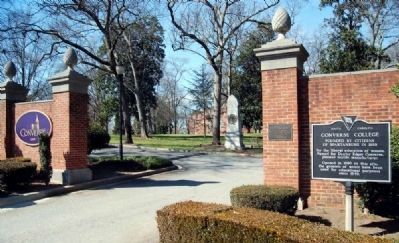
Photographed By Brian Scott, February 14, 2011
6. Converse College Marker -
Founder's Monument in Rear Center
Metal Plaque on Right Column Reads
Founder's Monument in Rear Center
Metal Plaque on Right Column Reads
Mary Burgin Presnell Montgomery
In recognition of her munificence
of spirit which has enriched and
strengthened her community, her church,
and Converse College, this gateway and
front campus gardens are named.
The Board of Trustees
May 29, 1967
— Submitted February 20, 2011, by Brian Scott of Anderson, South Carolina.
2. Dexter Edgar Converse
Dexter Edgar Converse was born in Vermont, in 1828. He is the son of Orlin Converse, also a native of Vermont, and a grandson of Paine Converse, a farmer of Massachusetts and direct descendant of Edward Converse, who came from England to America with Governor Winthrop in 1620. His mother was Louisa Twichell, a native of Massachusetts and daughter of Peter Twichell. She died in 1888. When D. Edgar Converse was but three years old he was deprived by death of a father's care and was reared and educated chiefly in Canada at the home of an uncle, where he remained until he had reached the age of twenty-one. This uncle was, like his father, a woolen manufacturer, and it was from him that the young man received his first lessons in this business, in which he was destined to accomplish such wonderful success. In 1850, after reaching maturity, he went to Cohoes, N.Y., and being employed there in a cotton mill for five years he obtained a good knowledge of that business in all its branches. In
1855 he came South and after a brief connection with a cotton mill at Lincolnton, N.C., he removed to Spartanburg county, S.C., and found employment in a mill at Bivinsville, now known as Glendale. In a short time he acquired a proprietary interest and from that time has been one of the owners of the mill, holding now a controlling interest in the stock. At the beginning of the war he enlisted as a private in Company I of the Thirteenth South Carolina regiment, of which O.E. Edwards was colonel. His captain was D.R. Duncan. There was, however, such need of accomplished manufacturers that the Confederate government detailed him to return home and carry on the cotton manufacturing business, requiring of his company one-third of the product of their mill. He had shown his readiness to fight for the rights of the people among whom he lived, and they, as well as the government, preferred to use his services in another line. As soon as the war closed, Mr. Converse, with characteristic business foresight, urged upon his partners the importance of enlarging their mill. His partners, with good faith in his ability, heeded his advice and a fine new establishment was built, which business grew steadily as the ravages of war disappeared. He has been president of Glendale mills since. To Mr. Converse is due much of the credit for the wonderful progress that cotton manufacturing has made in the South. Others noted the prosperity of the Glendale mill, with the result that other mills sprang up in the vicinity, and Spartanburg county in now the greatest center of the cotton manufacturing industry of the South. In 1880, in connection with business associates, Mr. Converse purchased the water privilege and site of the old South Carolina iron works on Pacolet river, Spartanburg county, and here a new mill was built and the place called Clifton. There are now three mills there, aggregating 85,000 spindles, and a population of 6,000 people, all of whom are dependent upon this industry. Of the Clifton manufacturing company Mr. Converse has been president and business manager ever since its organization. He is a director in various other mills and in various banks. He is a trustee for the South Carolina institute for the deaf, dumb and blind. He is also the founder of Converse college for young women at Spartanburg. In buildings, grounds and educational advantages it ranks among the foremost institutions of our country. Mr. Converse's wife was Miss Helen A. Twitchell, of Cohoes, N.Y., and they have one daughter. Their home is one of the most attractive in the beautiful city of Spartanburg. (Source: Confederate Military History, Vol. V by Ellison Capers, 512-513.)
— Submitted April 28, 2011, by Brian Scott of Anderson, South Carolina.
3. The First President
In 1890, the Board of Directors called upon the minister of the First Presbyterian Church, Benjamin Franklin Wilson, to accept the role as the college's first president. Wilson was described as having a missionary zeal to serve humanity. This translated into a deep interest in each individual student at the new college. During the 12 years (1890-1902) that he served Converse, he set the pattern for later leadership with an emphasis on growth and high standards. A bond developed between Wilson and Edgar Converse that verged on a father-son relationship. Mr. Converse provided valuable support for the young president. Early in 1902, Wilson left Converse to pursue further study in Europe and at Harvard University. In 1905, he became minister of the First Presbyterian Church in Harrisonburg, Virginia, where he remained for 27 years. In 1929, Main Hall was renamed Wilson Hall. (Source: Converse College by Jeffrey Willis (2001), p 11.)
— Submitted April 28, 2011, by Brian Scott of Anderson, South Carolina.
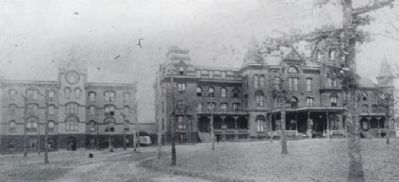
Converse College by Jeffrey R. Willis, circa 1889
10. Converse College -
Original Buildings
Original Buildings
In 1889, the trustees of the new college purchased the St. John College property from the Episcopal Diocese. The site had been the location of several attempts to establish an Episcopal school, first for boys and later a theological seminary. On the property was a chapel and two completed wings of a proposed main building. The college trustees completed Main Hall and erected an annex (shown on the left), which was later renamed Pell Hall.
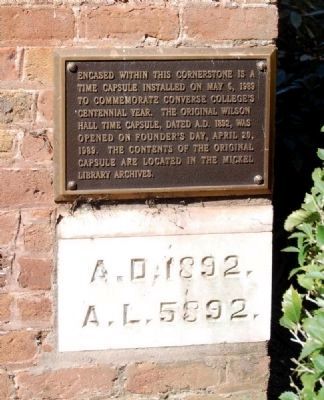
Photographed By Brian Scott, February 14, 2011
19. Wilson Hall (Main Hall) -
Cornerstone
Cornerstone
Encased within this cornerstone is a time capsule installed on May 6, 1989 to commemorate Converse College's Centennial Year. The original Wilson Hall Time Capsule, dated A.D. 1892, was opened on Founder's Day, April 20, 1989. The contents of the original capsule are located in the Mickel Library Archives.
A.D. 1892
A.L. 5892
A.L. 5892
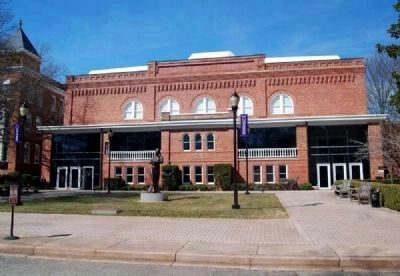
Photographed By Brian Scott, February 14, 2011
20. Twichell Auditorium -
1898-1899
1898-1899
In 1941, the Converse Auditorium was renamed Twichell Auditorium. Albert H. Twichell was the younger brother of Helen Converse. He was active in the cultural life of Spartanburg. He was the organist at the First Presbyterian Church and first president of the Converse Choral Society and the May Festival.
Credits. This page was last revised on November 30, 2020. It was originally submitted on November 18, 2007, by R. E. Smith of Nashville, Tennessee. This page has been viewed 2,796 times since then and 61 times this year. Last updated on July 12, 2008, by Brian Scott of Anderson, South Carolina. Photos: 1, 2, 3. submitted on November 18, 2007, by R. E. Smith of Nashville, Tennessee. 4. submitted on March 2, 2009, by Brian Scott of Anderson, South Carolina. 5, 6. submitted on February 20, 2011, by Brian Scott of Anderson, South Carolina. 7. submitted on April 28, 2011, by Brian Scott of Anderson, South Carolina. 8. submitted on March 18, 2009, by Mike Stroud of Bluffton, South Carolina. 9. submitted on November 18, 2007, by R. E. Smith of Nashville, Tennessee. 10, 11, 12, 13, 14, 15, 16, 17, 18, 19, 20. submitted on February 20, 2011, by Brian Scott of Anderson, South Carolina. 21. submitted on April 28, 2011, by Brian Scott of Anderson, South Carolina. 22. submitted on February 20, 2011, by Brian Scott of Anderson, South Carolina. 23, 24, 25. submitted on April 29, 2011, by Brian Scott of Anderson, South Carolina. • Kevin W. was the editor who published this page.
